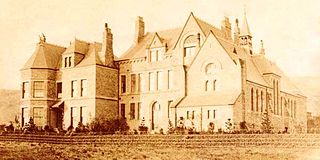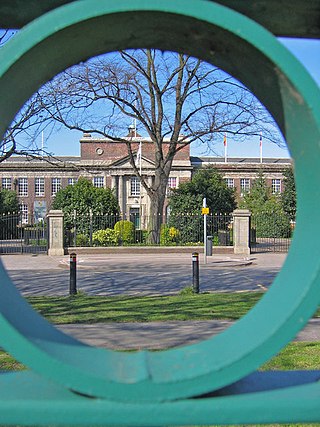
Sheldon School is a large mixed secondary school and sixth form in Chippenham, Wiltshire for students aged 11 to 18 and is the largest school in Wiltshire. Since April 2011, it has been an Academy. It is one of three secondary schools in Chippenham, the others being Abbeyfield and Hardenhuish. The school is headed by Peter Lynch, former Headteacher of Bradley Stoke Community School, who was appointed in September 2023.The school is off the Hardenhuish Lane in the southern region of Hardenhuish Park, which is all that separates it from Hardenhuish School to the north.
Sandhurst School is a coeducational secondary school and sixth form located in Sandhurst, Berkshire, England. The headteacher is Gareth Croxon.

Kingsbury High School is a large two-site high school with academy status in Kingsbury, London, England.

Itchen Sixth Form College is a mixed sixth form college in Bitterne, Southampton, Hampshire, England. It was established in 1906 and was originally a mixed secondary school, it later became Itchen Grammar School under the reforms of the Butler Education Act. It became its present state following further reform in the 1980s.

Lady Manners School is an English secondary school located in Bakewell, a market town in the Peak District National Park, Derbyshire. It was founded on 20 May 1636 by Grace, Lady Manners, who lived at Haddon Hall, the current home of Lord and Lady Edward Manners, and has also in the past been known as the Bakewell Grammar School. It is now a member of the Peak 11 group of secondary schools in the Peak District.

Derby School was a school in Derby in the English Midlands from 1160 to 1989. It had an almost continuous history of education of over eight centuries. For most of that time it was a grammar school for boys. The school became co-educational and comprehensive in 1972 and was closed in 1989. In 1994 a new independent school called Derby Grammar School for boys was founded.

Tupton Hall School is a coeducational secondary school and sixth form located in Chesterfield in the English county of Derbyshire. It is one of the largest secondary schools in the North East Derbyshire district, with a large body of students and one of the largest sixth forms in the county.

Derby College is a further education provider with sites located within Derbyshire. It delivers training in workplace locations across England.

Founded in 1675, Buxton College was a boys' Public School and, from 1923, a grammar school in Buxton, Derbyshire whose site has been expanded since 1990 to be used as the fully co-educational comprehensive Buxton Community School.
George Stephenson High School is a coeducational secondary school located in Killingworth, North Tyneside, England.

Malet Lambert is a secondary school for 11- to 16-year-old pupils in Kingston upon Hull, East Riding of Yorkshire, England. The school is situated on James Reckitt Avenue in the east of the city, its front facade overlooks East Park. Malet Lambert opened in 1932 and became a grammar school in 1944 before becoming a community comprehensive in 1969. The school converted to academy status in September 2015.

Richmond Park Academy is a secondary school with an academy status in the London Borough of Richmond upon Thames. The school is part of the Academies Enterprise Trust academy chain.
Retford Oaks Academy is a coeducational secondary school and sixth form located in the market town of Retford, Nottinghamshire, England, situated in the district of Bassetlaw.

Newquay Tretherras School is a secondary school with academy status in Newquay, Cornwall, England. The current headteacher is Samantha Fairbairn. The school first opened on 7 January 1954 and first secondary modern school to be built in Newquay.

Hardenhuish School is a large mixed secondary school and sixth form in Chippenham, Wiltshire, England, for students aged 11 to 18. Together with Abbeyfield School and Sheldon School, it is one of three secondary schools in the town with academy status. The school's headteacher is Lisa Percy.

New Mills School & Sixth Form is a comprehensive school, situated in the town of New Mills, in the north west of Derbyshire.

St George's Academy is a co-educational comprehensive secondary school based in the English market town of Sleaford in Lincolnshire, with a satellite school at nearby Ruskington.
Graham School is a coeducational secondary school in the west of Scarborough in North Yorkshire, England. It is situated to the west of the town within 22 acres (8.9 ha) of grounds. The school is on Woodlands Drive. The lower site on Lady Edith's Drive closed on 23 June 2017.
Ormiston Ilkeston Enterprise Academy (OIEA) is a coeducational secondary school with academy status, located on two sites in Ilkeston in the English county of Derbyshire.
George H. Widdows was an English architect who pioneered changes to school building design to enhance the health of school children. He was also responsible for the design of about 80 schools in Derbyshire, where he became Chief Architect.

















